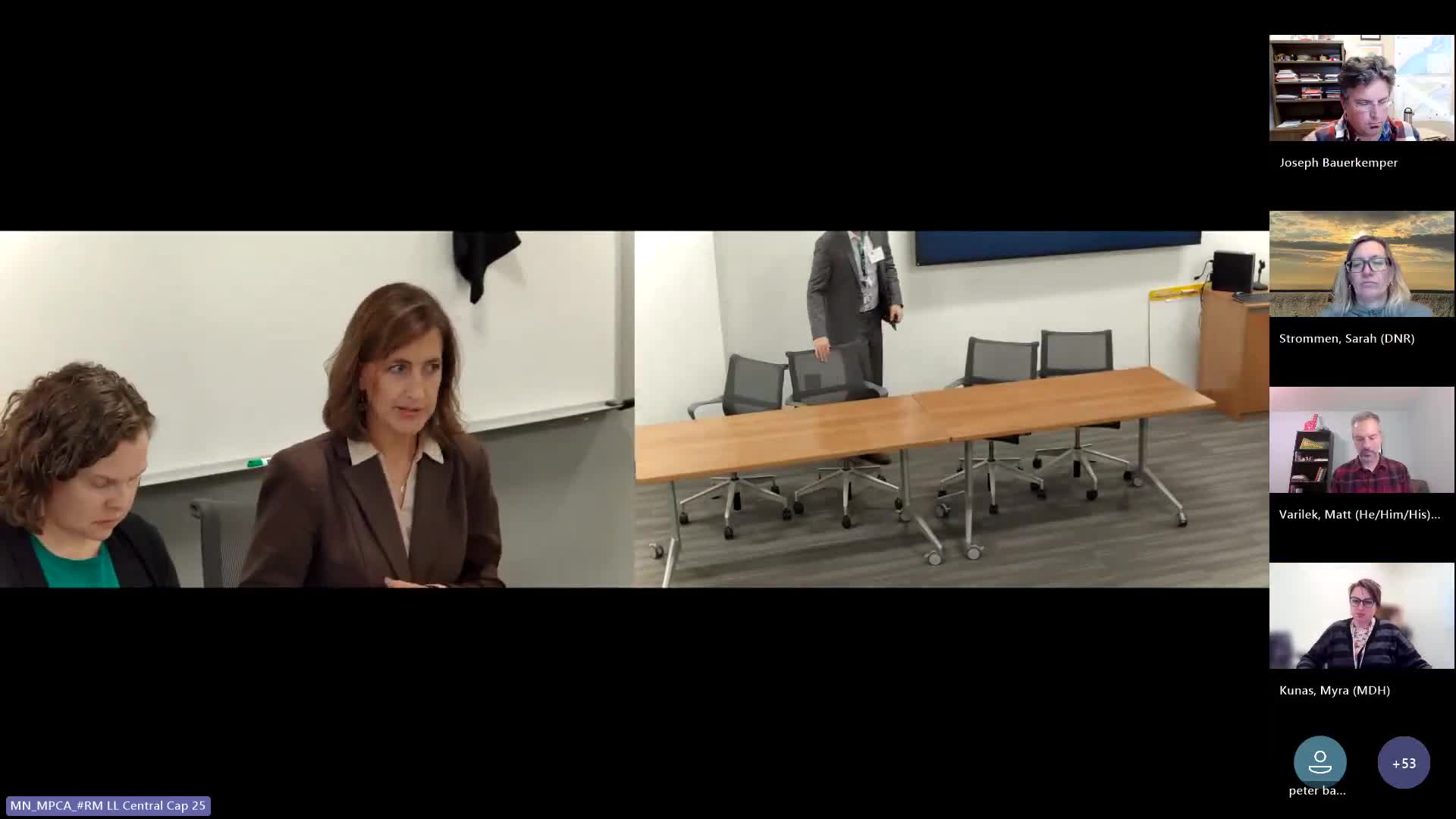State enterprise sustainability update: officials report progress on energy, water and waste goals
October 16, 2025 | Environmental Quality Board, Agencies, Boards, & Commissions, Executive, Minnesota
This article was created by AI summarizing key points discussed. AI makes mistakes, so for full details and context, please refer to the video of the full meeting. Please report any errors so we can fix them. Report an error »

At its Oct. 15 meeting the Environmental Quality Board received the annual update on state government sustainability activities for calendar year 2024 from Marcus Grubbs, director of the Office of Enterprise Sustainability in the Minnesota Department of Administration.
Grubbs described the enterprise governance model for sustainability, agency action plans, and six enterprise sustainability goals that the office tracks. He said the office manages reporting on thousands of utility meters across state‑owned facilities and supports agencies with planning, technical assistance and project implementation.
Key points from the presentation
- Goals and progress: Grubbs reviewed six goals for state operations, including reducing fossil‑fuel use in vehicle fleets, lowering energy use intensity (energy per square foot), measuring greenhouse‑gas emissions (tied to the Next Gen Energy Act), reducing water use intensity and increasing solid‑waste diversion. He said the enterprise has made a long‑term downward push on energy intensity for state buildings and reported that the enterprise achieved a 30% greenhouse‑gas reduction target (which Grubbs attributed largely to grid decarbonization).
- Procurement and sustainable purchasing: The office is expanding enterprise procurement reviews so that state and cooperative contracts increasingly include environmental standards; Grubbs described this as the second iteration of a procurement goal and said the intention is for preferred, lower‑impact products to become the default on enterprise contracts.
- Concrete projects and pilots: Grubbs cited agency projects — examples included the Minnesota Department of Natural Resources piloting Ford F‑150 Lightning vehicles in parks; the Minnesota National Guard readiness centers adding solar and ground‑source heat pumps; the Department of Corrections installing durable, water‑saving commercial washers projected to save about 1,100,000 gallons of water; and agency successes with organics diversion at 24‑hour facilities.
- Tools and workforce training: The office is offering a solar suitability workbook, expanding refrigerant accounting, forming a green lab user group and providing tuition for building operator training; it also encourages large agencies to hire energy managers.
- Awards and culture: The office highlighted agencies that won internal awards for sustainability leadership, including Minnesota Veterans Affairs for staff and resident engagement in sustainability projects.
Why it matters: Grubbs said the office seeks to lower operational costs and emissions while also sharing best practices across agencies. Board members praised the work and noted that progress on procurement, waste diversion and energy efficiency both lowers costs and builds resilience.
Ending: Board members asked a few clarifying questions and offered congratulations to agencies named in the report; no board action was taken on the report itself. The EQB will continue to receive annual updates and to coordinate with the Office of Enterprise Sustainability on future tools and agency action plans.
Grubbs described the enterprise governance model for sustainability, agency action plans, and six enterprise sustainability goals that the office tracks. He said the office manages reporting on thousands of utility meters across state‑owned facilities and supports agencies with planning, technical assistance and project implementation.
Key points from the presentation
- Goals and progress: Grubbs reviewed six goals for state operations, including reducing fossil‑fuel use in vehicle fleets, lowering energy use intensity (energy per square foot), measuring greenhouse‑gas emissions (tied to the Next Gen Energy Act), reducing water use intensity and increasing solid‑waste diversion. He said the enterprise has made a long‑term downward push on energy intensity for state buildings and reported that the enterprise achieved a 30% greenhouse‑gas reduction target (which Grubbs attributed largely to grid decarbonization).
- Procurement and sustainable purchasing: The office is expanding enterprise procurement reviews so that state and cooperative contracts increasingly include environmental standards; Grubbs described this as the second iteration of a procurement goal and said the intention is for preferred, lower‑impact products to become the default on enterprise contracts.
- Concrete projects and pilots: Grubbs cited agency projects — examples included the Minnesota Department of Natural Resources piloting Ford F‑150 Lightning vehicles in parks; the Minnesota National Guard readiness centers adding solar and ground‑source heat pumps; the Department of Corrections installing durable, water‑saving commercial washers projected to save about 1,100,000 gallons of water; and agency successes with organics diversion at 24‑hour facilities.
- Tools and workforce training: The office is offering a solar suitability workbook, expanding refrigerant accounting, forming a green lab user group and providing tuition for building operator training; it also encourages large agencies to hire energy managers.
- Awards and culture: The office highlighted agencies that won internal awards for sustainability leadership, including Minnesota Veterans Affairs for staff and resident engagement in sustainability projects.
Why it matters: Grubbs said the office seeks to lower operational costs and emissions while also sharing best practices across agencies. Board members praised the work and noted that progress on procurement, waste diversion and energy efficiency both lowers costs and builds resilience.
Ending: Board members asked a few clarifying questions and offered congratulations to agencies named in the report; no board action was taken on the report itself. The EQB will continue to receive annual updates and to coordinate with the Office of Enterprise Sustainability on future tools and agency action plans.
View full meeting
This article is based on a recent meeting—watch the full video and explore the complete transcript for deeper insights into the discussion.
View full meeting
